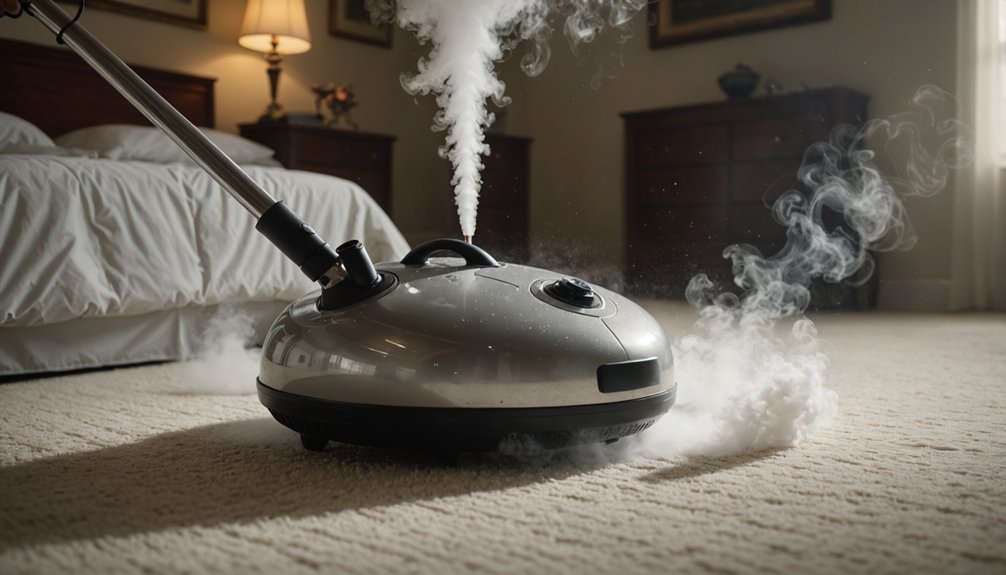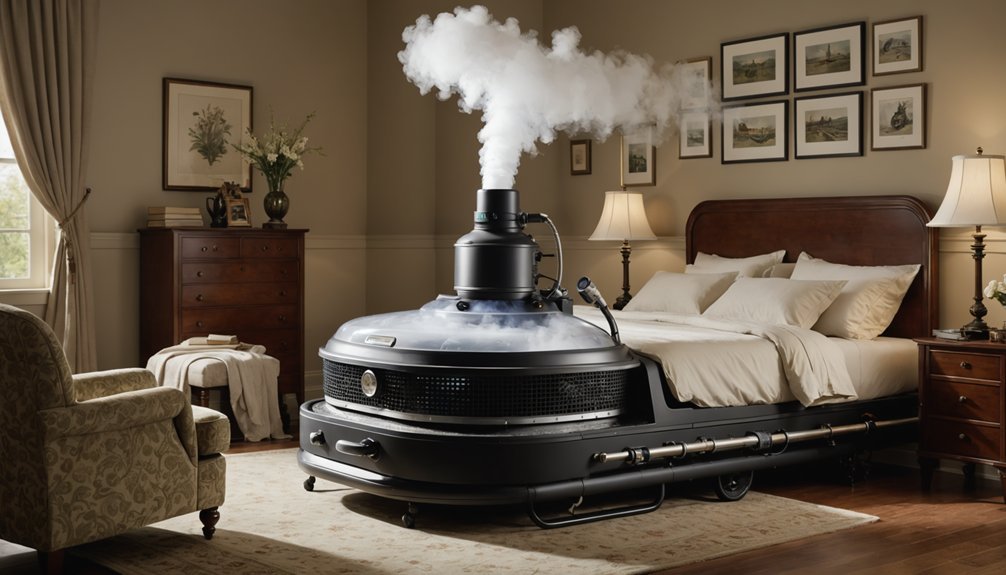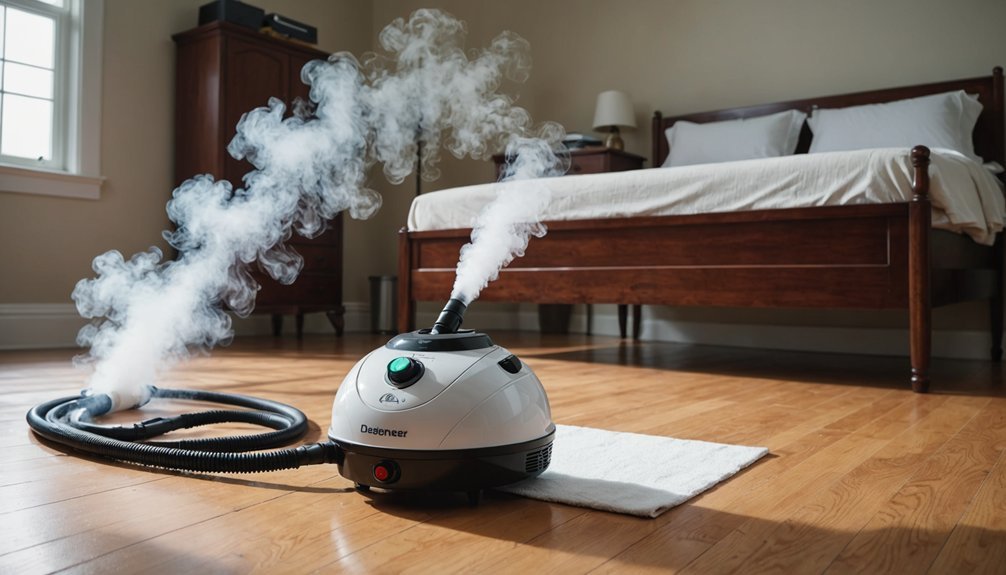Do Steamers Kill Bed Bugs? Step-by-Step Guide
If you’re battling bed bugs, you’ve probably wondered whether steam treatment can eliminate these persistent pests. The good news is that steam can effectively kill bed bugs at all life stages – but only when you follow the right process. While many homeowners turn to chemical treatments first, steam offers a non-toxic alternative that penetrates deep into fabric and crevices. Let’s explore how you can harness steam’s power against these unwanted intruders.
Key Takeaways
- Steam effectively kills bed bugs at temperatures above 113°F by causing cellular damage, with 100% mortality within 24 hours.
- Professional steamers reaching 248°F-356°F provide instant kills when held 1-2 inches from surfaces for 10-20 seconds.
- Remove clutter, vacuum thoroughly, and launder infested fabrics before steam treatment to maximize effectiveness.
- Focus steaming on seams, crevices, and common hiding spots, moving slowly to ensure proper heat penetration.
- Use protective gear, manage moisture levels post-treatment, and combine with other control methods for best results.
The Science Behind Steam Treatment for Bed Bugs

Heat is the deadly force behind steam treatment‘s effectiveness against bed bugs. When you apply steam to infested areas, the moist heat penetrates surfaces and crevices, reaching bugs hiding in folds, seams, and cracks.
The high temperatures – above 45°C (113°F) – cause protein denaturation and cellular damage in bed bugs and their eggs. Studies show that bed bugs subjected to lethal heat exposure have a 100% mortality rate within 24 hours.
You’ll find that steam treatment works across all life stages, from eggs to adults. The heat disrupts embryonic tissue in eggs, preventing hatching, while causing rapid desiccation and protein coagulation in nymphs and adults.
Even short exposures of 10-30 seconds per area can achieve complete mortality. Unlike chemical treatments, steam doesn’t leave hazardous residues or face resistance issues, making it a reliable method for eliminating these pests.
Choosing the Right Steamer for Maximum Effectiveness

When selecting a bed bug steamer, you’ll need one that reaches at least 120°C (248°F) to effectively kill both bugs and eggs on contact.
Your steamer should maintain consistent heat output and include specialized attachments for reaching cracks and crevices where bed bugs hide. The McCulloch MC1375 delivers excellent performance with its variable steam control system.
Consider investing in a model with a larger water tank and continuous steam capability to guarantee thorough treatment without frequent refills.
Temperature Range Requirements
To effectively eliminate bed bugs with steam, you’ll need a steamer that delivers and maintains temperatures between 160°F to 180°F at the surface level.
While bed bugs die at temperatures above 122°F, higher temperatures guarantee faster kill times and better egg elimination. Professional-grade steamers typically output steam between 320°F to 356°F, which instantly kills both bugs and eggs on contact.
You’ll want to monitor surface temperatures using an infrared thermometer to verify you’re reaching lethal levels. If you notice temperatures falling below 160°F, slow down your steaming pace or move the nozzle closer to the surface.
Using a commercial steamer capacity of at least 1 gallon ensures sufficient steam volume for thorough treatment.
Be careful not to exceed 180°F, as this could damage fabrics or materials. For best results, make sure your steamer maintains consistent heat output and avoid oversaturating surfaces with moisture.
Features Worth Investing In
Selecting a steamer with the right features can make the difference between successful bed bug elimination and wasted effort.
Look for models with larger tanks (1.6L or more) that provide at least 40 minutes of continuous steam, reducing interruptions during treatment. You’ll want multiple attachments, including fabric nozzles and crevice tools, to effectively reach bugs hiding in various spots. A steamer that heats up in 15 seconds like modern models ensures you can start treatments immediately without delays.
Choose a steamer that delivers high pressure (40+ PSI) and dry steam for better heat penetration and quick drying.
Safety features like auto shut-off and cool-touch hoses are essential for extended use.
Consider portability factors such as weight, cord length, and ergonomic design to guarantee you can thoroughly treat all affected areas without fatigue.
A quality warranty often indicates the manufacturer’s confidence in the product’s durability.
Essential Safety Precautions Before You Start

You’ll need to protect yourself with essential safety gear including heat-resistant gloves, protective eyewear, and a face mask before operating the steamer.
Make sure to remove or cover electronics and electrical outlets in the treatment area, as steam can cause short circuits and damage sensitive equipment.
Keep all power cords away from the steaming zone and guarantee proper ventilation throughout the process. Using a commercial-grade steamer provides the most reliable and thorough bed bug elimination results.
Proper Protective Equipment Required
Before tackling bed bugs with a steamer, proper protective equipment stands as your first line of defense against burns, respiratory issues, and bug bites.
You’ll need heat-resistant gloves to protect your hands from hot steam and surfaces.
Don’t forget safety goggles to shield your eyes from steam exposure, and wear a high-quality respirator mask rated for fine particles to prevent inhaling allergens or contaminants.
Cover your body with long-sleeved clothing and pants to guard against steam burns and potential bug bites.
Make sure you’re wearing closed-toe shoes with non-slip soles to prevent accidents during treatment.
This protective gear isn’t optional – it’s essential for your safety when using steamers that reach temperatures of 180°F (82°C) to effectively kill bed bugs.
Keep Electronics Away Safe
Three critical precautions can protect your electronics when steam treating for bed bugs.
First, remove all electronic devices from the treatment area before you begin steaming. If you can’t remove certain electronics, unplug them and remove any batteries to prevent electrical hazards.
Second, maintain a safe distance between your steamer and any electronics that must remain in the room, as steam temperatures above 113°F can damage sensitive components and melt internal circuits.
Finally, if you need to treat electronics for bed bugs, don’t use steam directly on them. Instead, seal your devices in thick plastic bags (at least 2mm) and use chemical vapor strips.
Store the sealed electronics in a well-ventilated area for 10-14 days to guarantee effective treatment without risking heat damage.
Step-by-Step Steam Treatment Process
Successfully treating bed bugs with steam requires five essential steps that must be performed methodically.
First, prepare your space by removing clutter and laundering all fabrics in hot water.
Second, fill your commercial-grade steamer with water and select the appropriate nozzle – wide for mattresses, narrow for cracks.
Third, position the steamer 1-2 inches from surfaces and move slowly at about 1 inch per second, angling slightly to let steam penetrate underneath bugs.
Fourth, maintain steam contact for 10-20 seconds per spot until surfaces reach 160-180°F, paying special attention to seams, tufts, and crevices. Focus on mattresses, bed frames, headboards, and furniture joints.
Finally, vacuum thoroughly after steaming to remove dead bugs and eggs, then inspect treated areas to guarantee complete coverage.
Common Mistakes to Avoid When Steam Treating
While proper steam treatment techniques are essential, many people make mistakes that can compromise their bed bug control efforts. Understanding these common errors will help you achieve better results in your bed bug battle.
1. You’re moving the steamer too quickly across surfaces, preventing the steam from reaching the critical temperature of 122°F needed to kill bugs and eggs.
Take your time to guarantee proper heat penetration.
2. You’re oversaturating materials by holding the steamer in one spot too long, which can lead to mold growth and damage.
Keep the nozzle moving steadily without soaking.
3. You’re missing hidden bed bug hideouts in deep crevices, electrical outlets, and tight spaces where steam can’t effectively reach.
4. You’re relying solely on steam treatment instead of combining it with other methods like mattress encasements, desiccants, and proper laundering.
Additional Methods to Support Steam Treatment Success
To maximize your steam treatment’s effectiveness against bed bugs, you’ll need to integrate several complementary control methods.
While steam treatment helps combat bed bugs, success requires a strategic combination of multiple pest control approaches.
Consider using heat treatments that raise room temperatures to 120°F-140°F to kill bugs in areas steam can’t reach. Install bed bug interceptors on furniture legs to trap migrating insects, and encase mattresses to prevent future infestations.
Before steaming, vacuum thoroughly and declutter your space to expose hiding spots.
After treatment, use dehumidifiers or fans to manage moisture levels and prevent potential damage. You can also incorporate freezing treatments like Cryonite for items sensitive to heat or moisture.
For lasting protection, work with a professional to apply residual insecticides in cracks and crevices where steam may have limited penetration.
Remember to launder infested fabrics at high heat for 15-30 minutes.
Conclusion
You’ll find that steam treatment is a powerful weapon against bed bugs when done correctly. Remember to use a professional-grade steamer, maintain proper distance and timing, and follow safety protocols. While steaming alone isn’t always enough to eliminate an infestation completely, it’s an effective part of an integrated pest management approach. Combine it with other methods for the best results in your bed bug battle. Additionally, it’s crucial to ensure that the areas being treated are thoroughly prepped to maximize the effectiveness of the steam treatment. For those looking to educate themselves further on how to eliminate bed bugs, consider consulting expert resources or pest management professionals who can provide valuable insights and tailored strategies. Remember, persistence and a multi-faceted approach remain key to a successful bed bug eradication effort.

